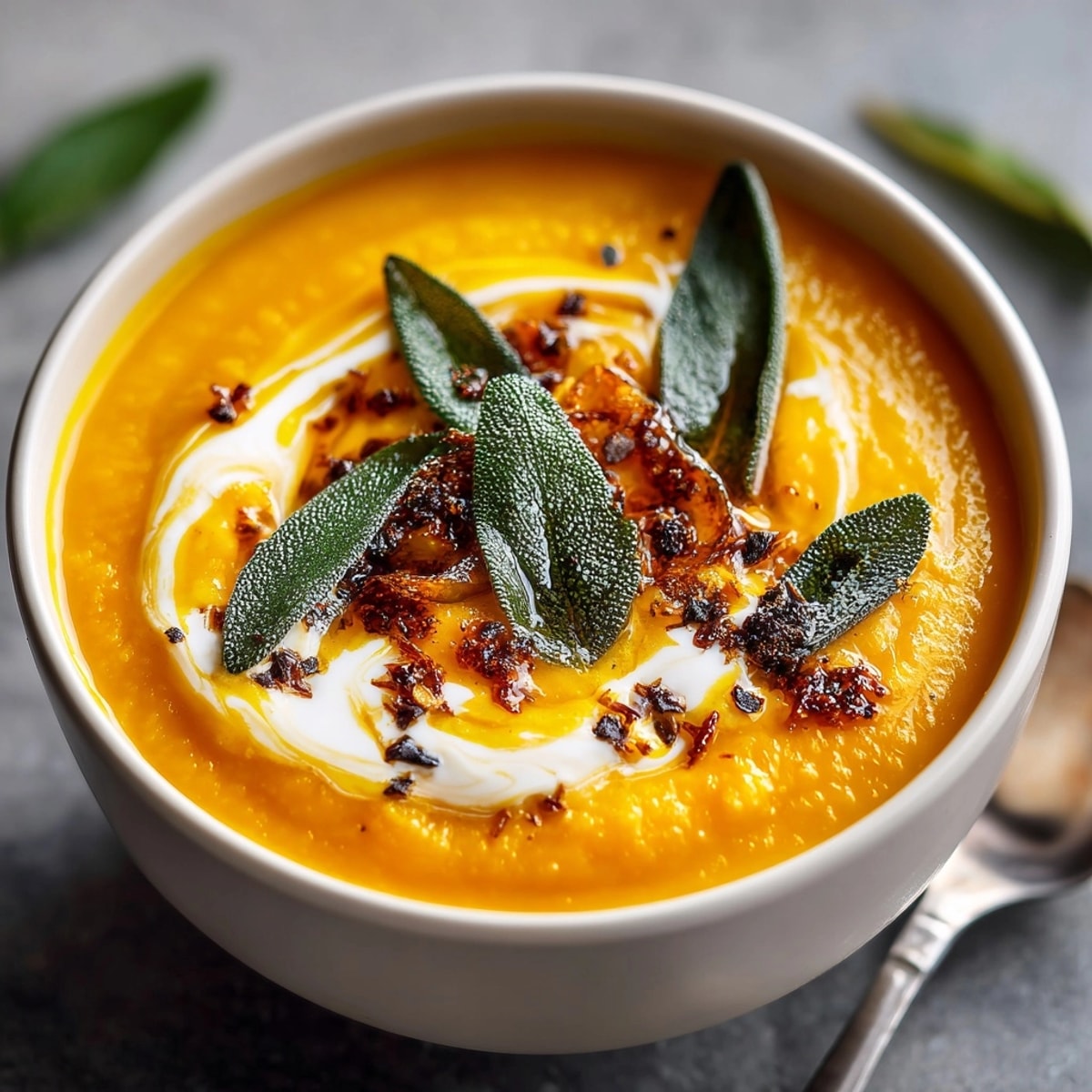 Save to Pinterest
Save to Pinterest This brown butter sage butternut squash soup brings all the cozy flavors of autumn into one comforting bowl. The squash roasts until caramelized and sweet, while deeply golden brown butter infuses every bite with nutty richness. Fresh sage adds earthiness and fragrance that makes this simple soup taste truly special on chilly evenings.
I first made this soup on a rain soaked October afternoon when I craved something soulful and satisfying. Now my friends ask for it at every fall gathering because everyone loves how it tastes like autumn in a bowl.
Ingredients
- Butternut squash: about two pounds peeled seeded and cubed A fresh and heavy squash means a sweeter soup with less water content. Look for one with matte skin and no soft spots
- Yellow onion: diced Gives the soup a mild sweetness and deepens the savory background. Select a firm onion with tight skin
- Garlic: minced Adds complexity and aromatic warmth. Choose fresh cloves for the brightest flavor
- Carrot: peeled and diced Natural sweetness that enhances the squash. Go for a carrot without cracks or browning
- Unsalted butter: Delivers rich nutty flavor when browned Use a high quality buttery staple for best results
- Fresh sage leaves: Infuses the soup with fragrant herby notes. Pick vibrant green leaves without yellowing
- Ground nutmeg: A pinch bring cozy spiced depth. Freshly grated will have the most aroma
- Salt and freshly ground black pepper: Essential for seasoning and balancing sweetness. Taste as you go for the best results
- Vegetable broth: The liquid base that walks the line between hearty and light. Use a low sodium broth for more control over seasoning
- Heavy cream (optional): Adds luxurious silkiness if you like it extra creamy. Go for a well chilled cream from a trusted dairy
- Additional browned butter for garnish: because you will want to swirl more on top
- Fresh sage leaves for crispy pretty garnish
Instructions
- Preheat and Prepare Vegetables:
- Set your oven to four hundred degrees Fahrenheit. Toss peeled cubed butternut squash and diced carrot with one tablespoon melted butter plus a few pinches of salt and cracked black pepper. Spread everything evenly on a rimmed baking sheet so the vegetables roast rather than steam
- Roast for Sweetness:
- Roast the squash and carrot for twenty five to thirty minutes until the edges start to caramelize and the interiors are easy to mash with a fork. Roasting transforms the simple squash into something irresistibly sweet and deeply flavored
- Brown the Butter With Sage:
- While the squash roasts melt three tablespoons butter in a large heavy pot over medium heat. Scatter sage leaves into the bubbling butter and watch carefully as the butter foams then develops a toasty golden color and nutty aroma after three to four minutes. Carefully scoop out the sage leaves to use as your crunchy garnish later
- Build the Aromatic Base:
- Add diced onion and minced garlic to the hot brown butter in the pot. Sauté for about four minutes until the onion becomes translucent and soft but not browned. This is where your soup develops most of its foundational savory flavor
- Combine Roasted Vegetables and Spices:
- Tip the roasted butternut squash and carrot directly into the pot. Sprinkle in the nutmeg and stir so everything is well coated in the brown butter and aromatics
- Simmer With Broth:
- Pour in the vegetable broth and bring everything to a gentle boil. Once bubbling reduce the heat and let the soup simmer for fifteen minutes which helps all the flavors mingle and the texture thicken
- Puree Until Silky Smooth:
- Take the pot off the heat. Use an immersion blender to puree the soup right in the pot until completely smooth. If you prefer a super silky texture or do not have an immersion blender transfer the soup in batches to a countertop blender and blend until velvety
- Finish and Serve:
- Stir in the heavy cream if using and taste for salt and pepper. Ladle the soup into warmed bowls. Swirl a spoonful of extra browned butter on top then scatter the crispy sage leaves over each serving for a stunning finish
 Save to Pinterest
Save to Pinterest The browned butter is always my favorite part Sometimes I sneak in an extra drizzle for myself before anyone sees. Last Thanksgiving my niece helped me crisp the sage leaves and ended up requesting her own bowl topped with as many as I would let her have.
Storage Tips
Let the soup cool completely before transferring to airtight containers. It keeps well in the fridge for up to four days. To reheat gently warm on the stove over low heat and add a splash of broth if it seems too thick. This soup also freezes beautifully just be sure to leave out the cream until after thawing and reheating. Frozen soup will keep for up to three months and makes a quick homemade lunch or cozy dinner.
Ingredient Substitutions
If you need a vegan option use your favorite vegan butter and swap the heavy cream for coconut cream or unsweetened oat milk. Chicken broth can replace the vegetable broth if you are not strictly vegetarian. Butternut squash may be swapped for other sweet winter squashes like kabocha or honeynut though each will subtly shift the flavor. Use shallots instead of onions for a more delicate taste. For added protein a scoop of cooked white beans blends in seamlessly and makes the soup extra filling.
Serving Suggestions
I love serving this soup with slices of toasted sourdough or chewy multigrain bread which are perfect for dunking. Sprinkle toasted pumpkin seeds or sunflower seeds on top for a nutty crunch. A crisp salad of apples and arugula alongside balances the creamy richness of the soup. For a heartier meal add a grilled cheese sandwich with sharp cheddar or gruyere. On festive occasions a simple swirl of crème fraiche makes the bowls look restaurant worthy.
Cultural Context
Butternut squash soup is a classic in many American kitchens especially in autumn when squashes reach their peak sweetness. Sage and browned butter are both deeply rooted in European and North American country cooking traditions for their ability to enhance simple seasonal ingredients. This style of soup captures the spirit of harvest time comfort food with techniques that date back generations.
Seasonal Adaptations
In early fall try using sweet dumpling or kabocha squash for variety Add a pinch of cinnamon or cayenne for extra warmth on extra chilly nights Make it with fresh summer squash for a lighter spring version
Success Stories
A friend of mine made this as her first ever homemade soup and could not believe how much depth the brown butter and sage added. Another time we made it together for a cozy dinner party and it outshone even the dessert. Even little kids find the sweet flavors irresistible when topped with extra crispy sage and buttery swirls.
Freezer Meal Conversion
Double the recipe and freeze in meal prep portions. When ready to eat simply thaw overnight in the fridge then gently reheat on the stove stirring in the cream right before serving. The flavors actually develop more depth after a day or two so it is ideal for freezing ahead of busy weeks or holiday meals.
 Save to Pinterest
Save to Pinterest This soup tastes even better after the flavors mingle in the fridge overnight. For autumn dinner parties or cozy weeknight meals, it is sure to become a seasonal favorite.
Common Recipe Questions
- → How do I achieve perfectly browned butter?
Cook butter over medium heat, stirring constantly, until it turns golden brown and has a nutty aroma. Watch closely to avoid burning.
- → Can I make it vegan?
Yes, substitute butter with vegan alternatives and use coconut cream or omit the cream entirely for a plant-based option.
- → What can I use instead of sage?
Try fresh thyme or rosemary for a different herbal note, but sage best complements the butternut squash’s sweetness.
- → What sides pair well with this soup?
Serve with crusty bread, pumpkin seeds, or a green salad for added texture and balance alongside the creamy soup.
- → Do I need to peel the squash first?
Yes, peeling and cubing ensures a smooth texture after roasting and blending. Use a sharp peeler to make it easier.
- → Can I freeze leftovers?
Absolutely. Cool the soup completely, transfer to airtight containers, and freeze for up to 2 months. Reheat gently before serving.